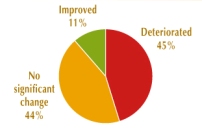
A ‘snapshot’ survey of changes in status 2000–2004, irrespective of changes in IUCN Red List category, showed that just 11% of globally threatened birds were judged to have improved. This indicates that threatened birds are in serious trouble, and that the problem is getting worse.

The Red List Index measures movement between categories of the IUCN Red List. However, these categories are relatively broad: species often have to undergo fairly significant changes in population size, population trend or range size in order to cross the thresholds between categories. To determine qualitative trends between 2000 (BirdLife International 2000) and 2004 (BirdLife International 2004) in the status of all globally threatened birds, not just those moving between Red List categories, a worldwide network of over 100 experts was consulted. They were asked to judge from their detailed knowledge whether the status of each species had improved, stayed the same, or deteriorated during the period. Assessments were obtained for 72% of threatened species (859 species). Of these, only 11% were judged to have improved in status, 44% had remained the same and 45% had deteriorated in status since 2000 (see figure). Similar proportions were found for the subset of Critically Endangered species: 14% were judged to have improved in status, 40% had stayed the same, and 46% had deteriorated in status. Of the species for which the experts scored ‘unknown’ status changes or for which no assessment could be obtained, many were also likely to have been declining. In combination with declining trends shown by the Red List Index, this ‘snapshot’ survey indicated that threatened birds are in serious trouble, and that the problem is getting worse.
References
Compiled: 2004
Recommended Citation:
BirdLife International (2004)
Most threatened birds are deteriorating in status.
Downloaded from https://datazone.birdlife.org/sowb/casestudy/most-threatened-birds-are-deteriorating-in-status on 22/12/2024